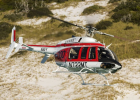Maintaining Autorotation Proficiency: Practice Vital To Helo Training
Avleak article about practice autos. Pretty good article, very long but very smart.
One point-
pilots of helicopters with low-inertia rotor systems may be unaware that aft cyclic must be applied when collective is lowered within seconds of losing engine power
This is generally true but it depends on type/model, especially the horizontal stab design. The H-60
Sikorsky Rube Goldberg stabilator practically does it for you. The horizontal stab on some TH-55s had the opposite effect and would make the aircraft "bunt," when the collective was lowered entering an auto, which could result in disastrous Nr decay (that is why the stall strips on the Bells is in the peculiar location on the "bottom" of the inverted airfoil). Either way, this comes back to what is going on with that blade element diagram
during the transition from powered to unpowered flight... helo aerodynamics isn't just some harassment package.


